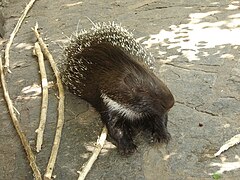Old World porcupine
| Old World porcupines Temporal range: Early Miocene–recent |
|
|---|---|
 |
|
| Old World porcupine | |
| Scientific classification | |
| Kingdom: | Animalia |
| Phylum: | Chordata |
| Class: | Mammalia |
| Order: | Rodentia |
| Suborder: | Hystricomorpha |
| Infraorder: | Hystricognathi |
| Family: |
Hystricidae Fischer de Waldheim, 1817 |
| Genera | |
The Old World porcupines, or Hystricidae, are large terrestrial rodents, distinguished by the spiny covering from which they take their name. They range over the south of Europe and the Levant, most of Africa, India, and the maritime Southeast Asia as far east as Flores. Although both the Old World and New World porcupine families belong to the Hystricognathi branch of the vast order Rodentia, they are quite different and are not closely related.
Old World porcupines are stout, heavily built animals, with blunt, rounded heads, fleshy, mobile snouts, and coats of thick cylindrical or flattened spines, which form the whole covering of their bodies, and are not intermingled with ordinary hairs. The habits of most species are strictly terrestrial. They vary in size from the relatively small long–tailed porcupine with body lengths of 27.9 to 48 cm (11.0 to 18.9 in), and a weight of 1.5 to 2.3 kg (3.3 to 5.1 lb), to the much larger crested porcupines, which are 60 to 83 cm (24 to 33 in) long, discounting the tail, and weigh from 13 to 27 kg (29 to 60 lb).
The various species are typically herbivorous, eating fruit, roots, and bulbs. Some species also gnaw on dry bones, perhaps as a source of calcium. Like other rodents, they have powerful gnawing incisors, and no canine teeth. Their dental formula is 1.0.1.31.0.1.3
...
Wikipedia
